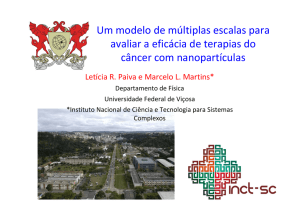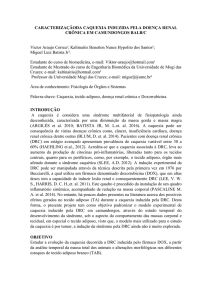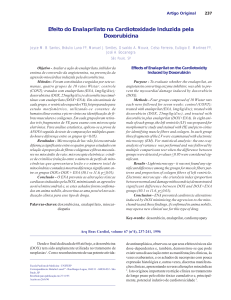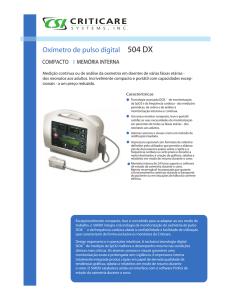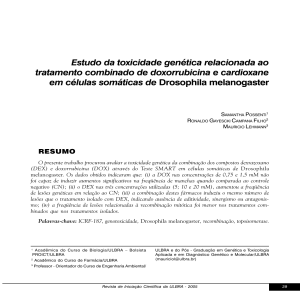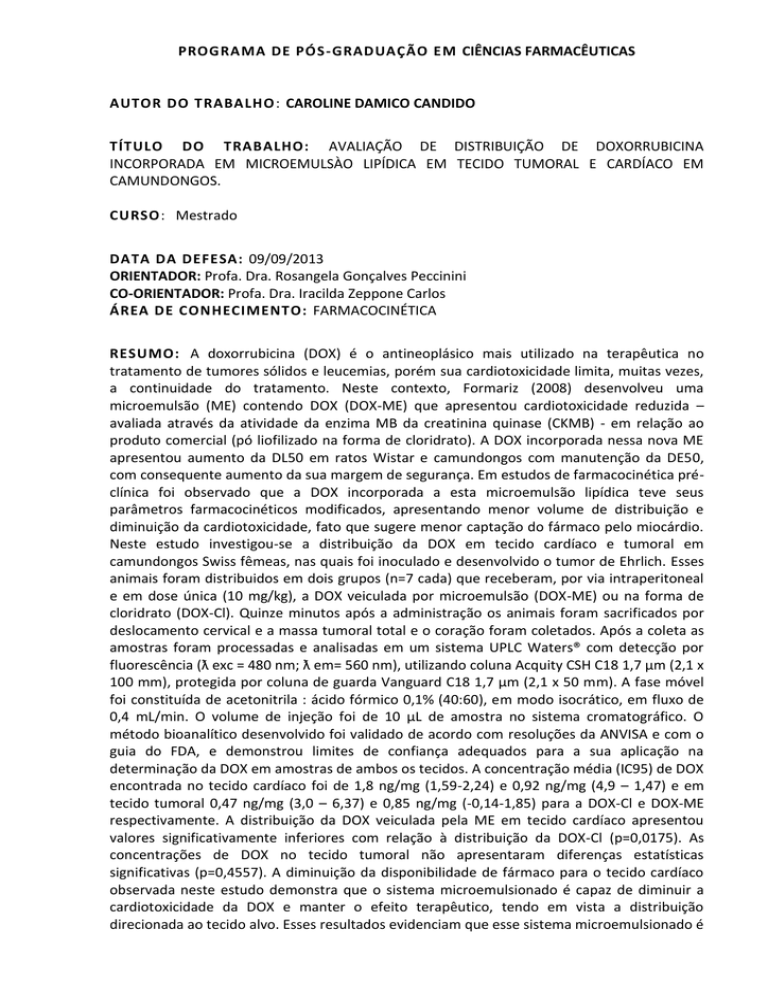
PROGRAMA DE PÓS-GRADUAÇÃO EM CIÊNCIAS FARMACÊUTICAS
AUTOR DO TRABALHO : CAROLINE DAMICO CANDIDO
TÍTULO DO TRABALHO: AVALIAÇÃO DE DISTRIBUIÇÃO DE DOXORRUBICINA
INCORPORADA EM MICROEMULSÀO LIPÍDICA EM TECIDO TUMORAL E CARDÍACO EM
CAMUNDONGOS.
CURSO: Mestrado
DATA DA DEFESA: 09/09/2013
ORIENTADOR: Profa. Dra. Rosangela Gonçalves Peccinini
CO-ORIENTADOR: Profa. Dra. Iracilda Zeppone Carlos
ÁREA DE CONHECIMENTO: FARMACOCINÉTICA
RESUMO: A doxorrubicina (DOX) é o antineoplásico mais utilizado na terapêutica no
tratamento de tumores sólidos e leucemias, porém sua cardiotoxicidade limita, muitas vezes,
a continuidade do tratamento. Neste contexto, Formariz (2008) desenvolveu uma
microemulsão (ME) contendo DOX (DOX-ME) que apresentou cardiotoxicidade reduzida –
avaliada através da atividade da enzima MB da creatinina quinase (CKMB) - em relação ao
produto comercial (pó liofilizado na forma de cloridrato). A DOX incorporada nessa nova ME
apresentou aumento da DL50 em ratos Wistar e camundongos com manutenção da DE50,
com consequente aumento da sua margem de segurança. Em estudos de farmacocinética préclínica foi observado que a DOX incorporada a esta microemulsão lipídica teve seus
parâmetros farmacocinéticos modificados, apresentando menor volume de distribuição e
diminuição da cardiotoxicidade, fato que sugere menor captação do fármaco pelo miocárdio.
Neste estudo investigou-se a distribuição da DOX em tecido cardíaco e tumoral em
camundongos Swiss fêmeas, nas quais foi inoculado e desenvolvido o tumor de Ehrlich. Esses
animais foram distribuidos em dois grupos (n=7 cada) que receberam, por via intraperitoneal
e em dose única (10 mg/kg), a DOX veiculada por microemulsão (DOX-ME) ou na forma de
cloridrato (DOX-Cl). Quinze minutos após a administração os animais foram sacrificados por
deslocamento cervical e a massa tumoral total e o coração foram coletados. Após a coleta as
amostras foram processadas e analisadas em um sistema UPLC Waters® com detecção por
fluorescência (ƛ exc = 480 nm; ƛ em= 560 nm), utilizando coluna Acquity CSH C18 1,7 μm (2,1 x
100 mm), protegida por coluna de guarda Vanguard C18 1,7 μm (2,1 x 50 mm). A fase móvel
foi constituída de acetonitrila : ácido fórmico 0,1% (40:60), em modo isocrático, em fluxo de
0,4 mL/min. O volume de injeção foi de 10 μL de amostra no sistema cromatográfico. O
método bioanalítico desenvolvido foi validado de acordo com resoluções da ANVISA e com o
guia do FDA, e demonstrou limites de confiança adequados para a sua aplicação na
determinação da DOX em amostras de ambos os tecidos. A concentração média (IC95) de DOX
encontrada no tecido cardíaco foi de 1,8 ng/mg (1,59-2,24) e 0,92 ng/mg (4,9 – 1,47) e em
tecido tumoral 0,47 ng/mg (3,0 – 6,37) e 0,85 ng/mg (-0,14-1,85) para a DOX-Cl e DOX-ME
respectivamente. A distribuição da DOX veiculada pela ME em tecido cardíaco apresentou
valores significativamente inferiores com relação à distribuição da DOX-Cl (p=0,0175). As
concentrações de DOX no tecido tumoral não apresentaram diferenças estatísticas
significativas (p=0,4557). A diminuição da disponibilidade de fármaco para o tecido cardíaco
observada neste estudo demonstra que o sistema microemulsionado é capaz de diminuir a
cardiotoxicidade da DOX e manter o efeito terapêutico, tendo em vista a distribuição
direcionada ao tecido alvo. Esses resultados evidenciam que esse sistema microemulsionado é
uma alternativa promissora para melhorar a eficácia do antineoplásico e sua utilização na
terapêutica.
ABSTRACT:
Doxorubicin (DOX) is the most used antineoplastic in the therapy for the treatment of solid
tumors and leukemias but its cardiotoxicity often limits the continuity of the treatment. In this
context, Formariz (2008) developed a microemulsion (ME) containing DOX (DOX-ME) that
showed reduced cardiotoxicity - assessed by the activity of the enzyme creatine kinase MB
(CK-MB) - in relation to the commercial product (in the form of hydrochloride lyophilized
powder). The DOX incorporated into the new ME showed an increase of LD50 in rats and mice
with the maintaining of the ED50, consequently increasing its safety margin. In preclinical
pharmacokinetic studies was observed that the DOX lipid microemulsion had its
pharmacokinetic parameters modified, with smaller volume of distribution and reduced
cardiotoxicity, which suggests less drug uptake by the myocardium. In this study was
investigated the distribution of DOX in cardiac tissue and tumor in female Swiss mice, which
were inoculated and developed Ehrlich tumor. These animals were divided in two groups (n =
7) that received intraperitoneal dose (10 mg / kg) of DOX microemulsion (ME DOX) or
hydrochloride (DOX-Cl) . Fifteen minutes after the administration, the animals were sacrificed
by cervical dislocation and the total tumor mass and heart were collected. After collecting, the
samples were processed and analyzed on a Waters ® UPLC System with fluorescence
detection (ƛ exc = 480 nm; ƛ em = 560 nm) using column Acquity CSH C18 1.7 micrometre (2.1
x 100 mm) protected by guard column C18 Vanguard 1.7 micrometre (2.1 x 50 mm). The
mobile phase consisted of acetonitrile: 0.1% formic acid (40:60) in isocratic flow at 0.4 ml /
min. The injection volume was 10 uL of sample into the chromatographic system. The
bioanalytical method was validated in accordance with resolutions of ANVISA and the
guidance of the FDA, and demonstrated confidence limits appropriate for their application in
the determination of DOX in samples of both tissues. The average concentration (IC95) of DOX
found in cardiac tissue was 1.8 ng / mg (1.59 to 2.24) and 0.92 ng / mg (4.9 to 1.47) in tumor
tissue and 0 , 47 ng / mg (3.0 to 6.37) and 0.85 ng / mg (-0,14-1,85) to DOX and DOX-Cl ME
respectively. The distribution of DOX conveyed by ME in cardiac tissue showed significantly
lower values with respect to the distribution of DOX-Cl (p = 0.0175). The concentrations of
DOX in tumor tissue showed no statistically significant differences (p = 0.4557). The decreased
supply of drug to the cardiac tissue observed in this study demonstrates that the
microemulsion system is capable of reducing the cardiotoxicity of DOX and maintain a
therapeutic effect in view of the distribution directed to the target tissue. These results show
that the microemulsion system is a promising alternative to improve the efficacy of anticancer
and expand its use in therapy.
BANCA EXAMINADORA:
Titulares: Profa. Dra. Rosangela Gonçalves Peccinini
Prof. Dr. Anselmo Gomes de Oliveira
Profa. Dra. Thalita Pedroni Formariz Pilon
Suplente: Prof. Dr. Carlos Cesar Crestani
BIBLIOTECA DEPOSITÁRIA: Biblioteca da Faculdade de Ciências Farmacêuticas
de Araraquara-UNESP - Rodovia Araraquara-Jaú, km 1 – Araraquara-SP



